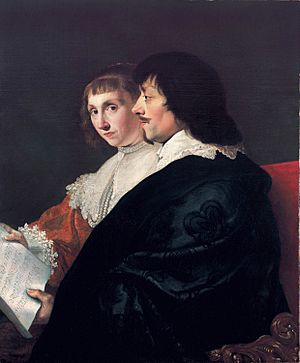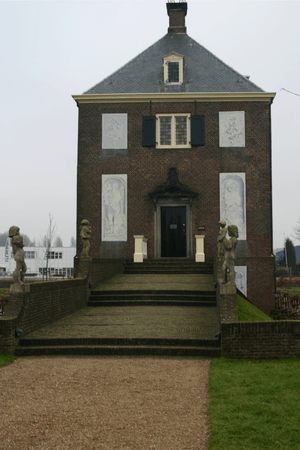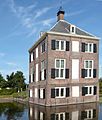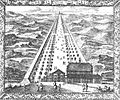Constantijn Huygens facts for kids
Quick facts for kids
Sir
Constantijn Huygens
|
|
|---|---|

Huygens, painted by Michiel Jansz van Mierevelt in 1641
|
|
| Born | September 4, 1596 |
| Died | March 28, 1687 (aged 90) |
| Resting place | Grote Kerk, The Hague |
| Nationality | Dutch |
| Education | University of Leiden |
| Occupation | Stadtholder, poet, composer, architect |
| Spouse(s) | Suzanna van Baerle |
| Children | Christiaan Huygens, Constantijn Huygens Jr., Lodewijk Huygens, Philips Huygens, Susanna Huygens |
| Parents |
|
Sir Constantijn Huygens (born September 4, 1596 – died March 28, 1687) was a very talented person from the Dutch Golden Age. He was a well-known poet and composer.
Constantijn Huygens also worked as a secretary for two important leaders of the Netherlands. These leaders were Prince Frederick Henry and Prince William II. He was also the father of the famous scientist Christiaan Huygens.
Contents
About Constantijn Huygens
Constantijn Huygens was born in The Hague, which is in the Netherlands. He was the second son of Christiaan Huygens senior. His father was a secretary for the government. His mother was Susanna Hoefnagel.
Early Education
Constantijn was a very smart child. He and his brother, Maurits, were taught at home. Their father and special teachers helped them learn many things.
When Constantijn was five, he and his brother started learning music. They began with singing lessons. They even learned music notes using gold buttons on their jackets!
Music Skills
Constantijn learned to play the viol, lute, and harpsichord. He was especially good at the lute. By age eleven, he was already playing for groups. Later, when he traveled for work, people often asked him to play the lute. He even played for kings!
In 1647, he published a book of his music called Pathodia sacra et profana. It included songs in French, Italian, and Latin.
Art and Languages
Constantijn also learned about art. His parents had a collection of paintings. They also knew a diamond dealer in Antwerp who had many beautiful artworks.
Constantijn was very good at learning languages. He learned French, Latin, and Greek language. Later, he also learned Italian, German, and English. He learned these languages by practicing them often.
He also studied math, law, and logic. He even learned how to use a pike and a musket.
In 1614, Constantijn wrote his first poem in Dutch. It was about how wonderful country life is.
University Life
In 1616, Constantijn and Maurits started studying at Leiden University. Going to university was a way to meet important people. Constantijn finished his studies in 1617. After that, he trained with a lawyer named Antonis de Hubert.
Starting His Career
In 1618, Constantijn started working for Sir Dudley Carleton. Sir Dudley was the English ambassador in The Hague. Constantijn then went to London and lived with the Dutch ambassador. In London, he met many new people and learned to speak English well.
In 1620, he traveled to Venice as a secretary. He was part of a group trying to get support for the Netherlands. He was the only one in the group who could speak Italian.
Trips to England
In 1621, Constantijn went to England again. He was part of a group asking King James I to support the Netherlands. They met King James and Prince Charles. Constantijn returned home with a valuable gold chain from the King. He made several more trips to England in the following years.
Meeting Famous Writers
Constantijn was part of a group of smart people called the Muiderkring. This group met at a castle near Amsterdam. In 1619, he met writers like Anna Roemers Visscher and Pieter Corneliszoon Hooft. He often exchanged poems with them.
In 1623, Huygens wrote Printen. This was a funny but serious poem about different kinds of people. He also wrote verses for the wedding of Maria Tesselschade. In 1625, he published Otia, a collection of his poems.
Knighthood and Marriage

In 1622, while working as a diplomat in England, Constantijn was made a knight by King James I. This was a big honor for him.
Constantijn became a secretary for Frederick Henry, Prince of Orange. Prince Frederick Henry became the new leader after Maurits of Orange died.
In 1626, Constantijn fell in love with Suzanna van Baerle. He wrote many sonnets for her, calling her his "Sterre" (Star). They got married on April 6, 1627.
Huygens wrote a long poem called Dagh-werck about their marriage. It described a day in their life together. Suzanna even helped write parts of it.
Constantijn and Suzanna had five children:
- Constantijn Jr. (born 1628)
- Christiaan (born 1629)
- Lodewijk (born 1631)
- Philips (born 1633)
- Susanna (born 1637)
Sadly, Suzanna died shortly after Susanna was born.
Later Life and Honors
Even after his wife's death in 1637, Huygens continued his successful career. In 1630, he got a job managing the money for the Orange family. This job gave him a good income. In the same year, he bought some land and became known as Lord of Zuilichem.
In 1632, the King of France, Louis XIII of France, made him a Knight of the Order of Saint-Michel. This was another important honor. In 1643, Huygens was allowed to put a golden lily on his family's coat of arms.
In 1634, Prince Frederick Henry gave Huygens some land in The Hague. It was near the land of his friend, Count Johan Maurits. Both men built their houses around the same time, using the same architect, Jacob van Campen.
Friends and Writings
Huygens was friends with many famous people. He knew René Descartes, a philosopher, and painters like Rembrandt and Jan Lievens. He also became friends with the English poet John Donne and translated his poems into Dutch.
After his wife died, Huygens was too sad to write poetry for months. But eventually, he wrote a sonnet called Op de dood van Sterre (On the death of Sterre). He added this poem to his unfinished work, Dagh-werck. He published it in 1658 as part of his book Koren-bloemen.
Hofwijck Estate
After a few years as a widower, Huygens bought land in Voorburg. He had a house built there called Hofwijck. It was finished in 1642. Huygens hoped to relax there away from his busy court life. The name Hofwijck means "Court" (like a royal court) and "avoid" or "township."
In 1644, a beautiful portrait of Huygens was painted by Daniel Seghers and Jan Cossiers. It is now in the Mauritshuis museum. In 1647, he published Ooghentroost, a poem written to comfort a friend who was losing her eyesight.
From 1650 to 1652, Huygens wrote the poem Hofwijck. In it, he described how much he enjoyed living outside the city. He wrote this poem after many of his friends and family members had died.
Family and Later Years
In 1645, Constantijn's sons, Constantijn Jr. and Christiaan, started studying in Leiden. Prince Frederick Henry, who was Huygens' friend and protector, became very sick and died in 1647. The new leader, William II, also died in 1650.
Huygens became the head of the Council for the young Prince of Orange, who was still a baby. He traveled often for this job.
In 1657, his son Philips died while traveling. That same year, Huygens became very ill but recovered.
In 1680, Constantijn Jr. and his family moved out of his father's house. To stop rumors, Huygens wrote a poem called Cluijs-werck. It gave a glimpse into his later life.
His Writings and Music
In 1647, some of Huygens' music, Pathodia sacra et profana, was published in Paris. It included songs in Latin, French, and Italian.
In 1648, Huygens wrote Twee ongepaerde handen for the harpsichord. He shared his love for music with a harpsichord player named Marietje Casembroot.
In 1657, his collected Dutch poems, Koren-bloemen, were published. This book included Heilighe Daghen (1645), Ooghen-troost (1647), Hofwijck (1653), and Trijntje Cornelis (1653). Trijntje Cornelis showed how creative Huygens was with language.
In 1660, his daughter Susanna married her cousin. In 1661, Huygens traveled to France to get back some land for the Orange family. The land was returned in 1665, and Huygens came back to the Netherlands.
When he returned, Huygens designed a new sand road in The Hague. This road went through the dunes to Scheveningen. He had planned this road in 1653 and wrote about it in his work Zee-straet. The road was built according to his design.
In 1676, a second edition of Koren-bloemen was published. It was a large collection with 27 books. As he grew older, Huygens found comfort in music. He wrote about 769 musical pieces during his life.
Legacy
Constantijn Huygens died in The Hague on March 28, 1687, at the age of 90. He was buried in the Grote Kerk in The Hague. His son, the scientist Christiaan Huygens, was later buried with him.
In 1947, a literary award was created to honor him. It is called the Constantijn Huygens Prize.
Images for kids
See also
 In Spanish: Constantijn Huygens para niños
In Spanish: Constantijn Huygens para niños





